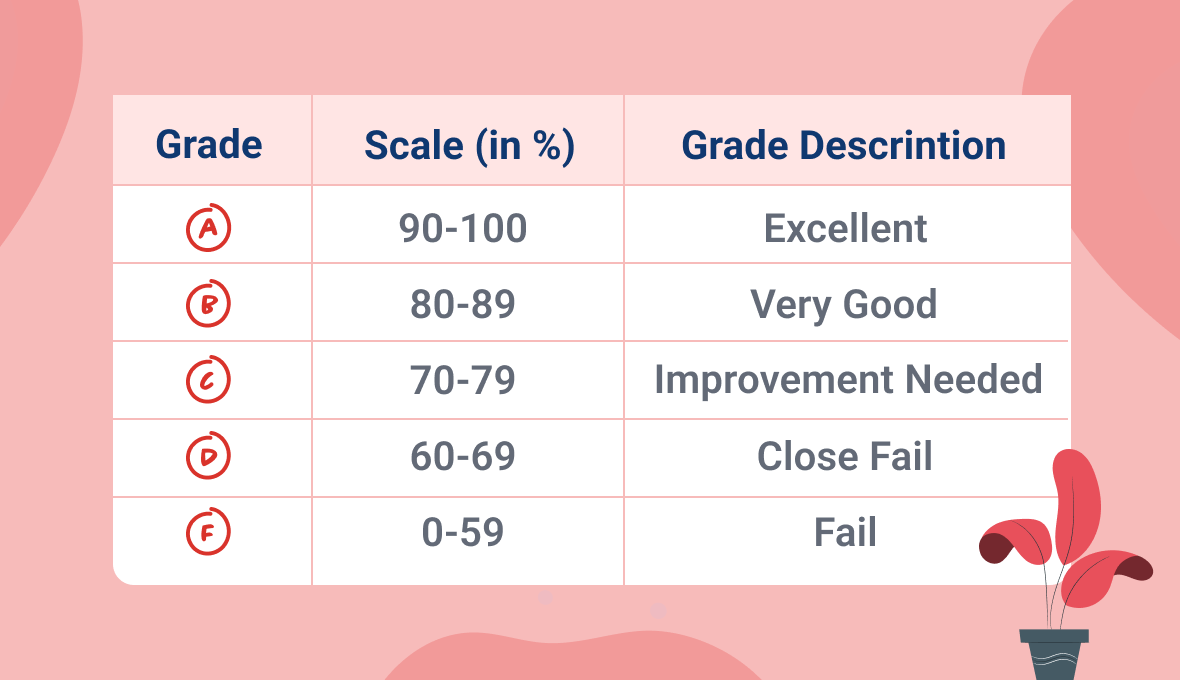
A's and B's: The True Story Behind the Letter Grades
US Grading System: An Overview
Grading systems for schools vary around the world. However, in the United States, most schools use a letter-grading system, with A being the highest grade and F being the lowest. This system originated in the late 19th century when primary and secondary schools, along with higher education institutions, began standardizing their grading criteria and defining their grading scale of choice.
The letter grades scale originally had a different meaning than it does today; for example, an A indicated that a student met all of the requirements for the course, while a B meant that the student had met most of the requirements. Today, letter grades are often given on a percentage scale, with A representing 90-100%, B representing 80-89%, and so on. This system is designed to give students and parents a clear idea of how well a student performs in school. While it is not perfect, it is still widely used in the United States and other countries.
In this article, we'll explore the letter grading system in the United States at length and compare it to that of the United Kingdom. We're also going to talk about grade point averages (GPAs), their importance, and the other grading systems. So, sit back, relax, and get ready to learn all you need to know about grading systems from annotated bibliography writing services!
What are the Grade Classifications?
The United States grading system uses letter grades to evaluate student progress. An excellent grade is between 90 and 100, which corresponds to an "A", 80-89 is a "B", 70-79 is a "C", 60-69 is a "D" and anything below 60 is an "F". However, there are also several variations of these college letter grades. For example, some schools use a plus/minus system, so an "A" could be between 90-93, and 94-100 would be an "A+".
There are also occasionally grades below a "D", such as an "F-" or even an "F". In addition, some schools use different systems, such as Pass/Fail or Satisfactory/Unsatisfactory. Say, if you recruit a nursing essay writer, you may want to discuss with them your school’s particular grading system as you start your collaboration. This way, you ensure you’re on the same page regarding your grade expectations – whether those will be on the A to F or Pass/Fail scale.

However, most schools in the United States use the standard letter grade system, making it easy to differentiate where you rank in student performance by keeping our explanation above in mind.
Navigating through letter grades in high school is more than just a reflection of academic understanding; it's a stepping stone towards future educational opportunities. As high school seniors eye the transition to college, securing financial support through scholarships becomes crucial. A strong academic record, reflected in your grades, can open doors to substantial scholarships. Explore the best college scholarships for high school seniors to find a range of financial aid opportunities that can ease the path towards achieving your college aspirations.

What Is a GPA, and Why Is It Important?
GPA, or Grade Point Average, is a numerical way of measuring how well a student is doing in school. The GPA scale goes from 0 to 4.0, with 4.0 being the highest possible score. Each letter grade corresponds to a certain GPA: A = 4.0, A- = 3.7, B+ = 3.3, B = 3.0, and so on.
GPAs are used for many different things, such as determining whether a student can graduate, get into college, or receive scholarships. In order to maintain high grades across the board, you can use the help of professional coursework writing services.
As for GPA classifications, there are three different types: class GPA, semester GPA, and cumulative GPA. Class GPA is the average of a student's grades in a particular class. A semester GPA is the average of all a student's grades during a semester of classes. Finally, cumulative GPA is the overall average of a student's grades throughout their academic career. All three types of GPAs are important, but cumulative GPAs are often given the most weight because they show how well a student has performed over an extended time period.
Regardless of which type of college GPA scale is being looked at, the higher the number, the better!
How is Your GPA Calculated?
As we mentioned earlier, your grade point average, or GPA, is a number that represents the average value of the grades you earn in college. If you want to learn how to calculate a GPA on a 4.0 scale, follow our simple steps below!
First, determine the numerical value of each letter grade you receive. For example, an A is worth 4 points; a B is worth 3 points, and so on. Next, add the total number of points for all your courses. Finally, divide this number by the total number of credits you've earned. This will give you your GPA for the semester.
Keep in mind that your GPA is just a single numerical representation of your academic performance. It's important to remember that grades are not everything. College is also about learning and personal growth, so don't let your GPA be the only measure of your success! However, if you want to get some help in boosting your GPA, a dissertation writing service is always a great idea - so don’t hesitate to connect with the best one to buy term paper online!
GPA Requirements for Admissions into US Universities
If you're looking to study at a university in the United States, there's a good chance that you'll need to meet certain GPA requirements. While every school is different, most universities in the US use a 4.0 GPA scale. This means that your GPA will need to be at least 4.0 to be eligible for admission.
In some cases, you may be able to get into a university with a lower GPA if you have other strong qualifications, such as high test scores or extracurricular activity participation. However, meeting the minimum GPA requirement is usually the best way to ensure your admission into a US university. So, if you're hoping to study in the States, make sure you focus on getting good grades and achieving a high GPA.
If you don't know what is a gpa scale or how to calculate grade point averages, you can consult our paragraph above to see a thorough explanation. On the other hand, if you want to find out how to convert GPA to a 4.0 scale, you should check out the requirements of the university you intend to apply. Most universities offer guidelines on what they deem to be the equivalent of foreign grading systems to theirs, so that will help you ensure that you're making the conversions the right way.
US vs. UK Grading Systems Comparison
The UK and US university grading systems are similar in some ways, but there are also significant differences. In the UK, universities typically use a 1–100-point scale, with 70 being a passing grade. In the US, however, letter grades are used (A, B, C, D, and F), with A being the highest and F being the lowest. In addition, the cut-off for a passing grade in the US is typically around 70%, though this can vary from school to school.
One of the most significant differences between the UK and US university grading practices is how grades are weighted. In the UK, all assignments are typically worth the same amount, regardless of difficulty or length. In the US, however, many schools weigh grades, so more complex or longer assignments are worth more points. This can make it easier to get a higher GPA in the US than in the UK.
Another difference is how exams are graded. In the UK, exams are typically worth a significant portion of the final grade (often 50% or more). In the US, exams are usually worth less (typically around 30%), with the rest of the grade coming from assignments and other assessment forms. This can make it easier to do well in classes with many exams in the UK than in the US.
Finally, there is a difference in how grades are reported between the different school systems. In the UK, universities usually give only the raw score (the 1-100 number). In the US, however, schools often report both the raw score and the letter grade. This can make it easier to compare grades between schools in the US than in the UK.
Overall, the UK and US university grading systems are similar, but there are also some important differences. These differences can affect how easy it is to get a high GPA, how exams are graded, and how grades are reported. So, if you're looking to see how to convert grades to numbers, just take a peek at the GPA conversion chart we shared above. This will give you an idea of how you're faring and how close you reach your academic grading goals in either school system.
Other Grading System Information
There are a few alternative grading systems to the number grades to letter system. For example, the pass/fail system is the most common, where students either pass or fail the class, with no intermediate grades awarded. This system is often used in classes not part of the student's major field of study.
Another system is the credit/no credit system, where students earn credits for passing the class but do not receive a letter grade. This system is often used for courses that are not required for graduation.
Finally, there is the standards-based grading system, where students are graded on their mastery of specific content standards rather than on a traditional A-F scale. This system is increasingly used in K-12 schools but is not as common in universities.
We'll look into alternative grading systems below, so keep reading along!
Standards-Based Grading
Standards-based grading (SBG) is an assessment method that focuses on students' understanding of the material rather than their performance on a single test or assignment.
This approach is based on the idea that it is more important for students to know and be able to apply key concepts than it is for them to simply earn a high grade. Therefore, under SBG, teachers typically provide students with multiple opportunities to demonstrate their understanding of the material. For example, this may require students to complete practice problems, write essays, or give oral presentations.
The teacher can provide additional support and resources if a student is having difficulty demonstrating their understanding. By contrast, in a traditional grading system, students and parents know what do the letter grades stand for, as the grading process is often based primarily on individual performance on summative assessments such as tests and final projects. While SBG requires more planning and effort on the part of teachers, many believe it is a more effective way to assess student learning.
Rank-Based Grading
In many school districts, the traditional A-F grading system and the GPA grade scale are replaced by rank-based grading. Under this new system, students are evaluated based on their relative performance compared to their peers rather than on an absolute scale. For example, if the top 10% of students in a class earn an A, then all students who fall into that top 10% would receive an A, regardless of how many points they earned.
Proponents of this new system argue that it more accurately reflects students' relative abilities and eliminates grade inflation. Critics, however, say that rank-based grading can be just as subjective as the traditional system and lead to even more competition among students. Ultimately, the decision of whether to use rank-based grading or not is up to each individual school district.
Six-Point System
The Six-Point System is a method of grading that assigns a score from 0 to 6 for each answer on a quiz or test. The scores are then totaled to determine the final grade. This system is often used in elementary and middle schools, providing a clear and concise way to assess student performance versus GPA to letter grades. Here is a closer look at the six possible scores:
0: This score indicates that the answer was completely incorrect or that the student did not attempt to answer the question.
1: This score indicates that the answer was partially correct or that the student made a minor error.
2: This score indicates that the answer was mostly correct, but there were some minor errors.
3: This score indicates that the answer was correct, but there were some major errors.
4: This score indicates that the answer was nearly perfect, but there was one small error.
5: This score indicates that the answer was perfect, with no errors whatsoever.
6: This score is typically reserved for questions requiring creative thinking or originality, indicating that the student went above and beyond in their answer.
As you can see, the Six-Point System provides a detailed perspective on a student's progress. By clearly outlining what is expected at each level, this system can help to ensure that all students are held to the same standard. In addition, by offering a scoring range from 0 to 6, this system allows for a more granular assessment of student progress. As a result, it is easy to see how even minor improvements can make a big difference in overall grades.
The 1-2-3-4 system
The 1-2-3-4 system is a simple, straightforward way to grade student work. Here's how it works:
For each assignment, students receive a score of 1, 2, 3, or 4. A score of 1 indicates that the student did not complete the task or that the work was subpar. A score of 2 indicates that the student completed the assignment but that the work was only average, while a 3 indicates that the student did an excellent job on the project. Finally, a score of 4 indicates that the student did an outstanding job on the assignment and was awarded the top grade on this system's scale.
This system has a few advantages over other traditional ways to assign grades, including the college letters grades system:
- It is easy for both teachers and students to understand how course grades are awarded.
- It provides clear guidelines for what is expected regarding the quality and quantity of work.
- It allows for more granular distinctions between levels of performance.
Of course, no grading system is perfect, and there's always the looming fear of potential grade inflation. The 1-2-3-4 system does have its limitations. For example, some assignments may be more complex than others and, therefore, warrant a more detailed grading rubric to better reflect the weight of giving correct answers. Additionally, this system does not account for factors such as classroom participation or growth over time. However, for many teachers and students, the 1-2-3-4 system is a helpful way to evaluate student progress and performance.
The E-S-N-U System
Too often, schools' grading practices can confuse students and parents. However, understanding how grades are assigned can help to demystify the process – and that's the goal of the E-S-N-U system. This grading method is commonly used as part of elementary and middle school curricula and is praised for its simplicity.
Under this system, grades are assigned based on the following criteria: effort, social interactions, necessary skills, and understanding of the material. Grades are given on a scale of 1 to 4 versus letter grades, with one being the lowest and four being the highest. For each criterion, a student can receive a score of 1, 2, 3, or 4. These scores are then totaled to arrive at the final grade shown on their report cards.
While the E-S-N-U system may seem complicated initially, it is a relatively straightforward way of assessing a student's performance. By taking the time to understand how grades are assigned, parents and guardians can better support their child's academic success.
Interesting Facts About US Grading System
Here's a concise list of the top things to know about the US grading system:
- The US grading system uses letter grades A through F, with A being the highest and F being the lowest. The latter is assigned when students fail a class, while the former is the top grade a student can achieve.
- The cutoff for a passing grade in the US is typically around 70%. However, this can vary from school to school and how students are assessed regarding meeting standards set forth by the various formal education school systems.
- In the US, many schools weigh grades so that more difficult or longer assignments are worth more points.
- In the US, exams are often worth less (typically around 30%), with the rest of the grade coming from assignments and other assessment forms.
- In the US, schools often report the raw score and the letter grade. This can make it easier to compare grades between different schools in the US than in the UK by making number grades to letter conversions.
No "E" Grades
In recent years, some schools have decided to do away with anything regarding letter grades to numbers and replace them with a "No E" policy. This means that instead of receiving a traditional letter grade, students are simply given a Pass or Fail for each assignment.
There are a few reasons why some schools have adopted this policy. There are a few reasons why some schools have adopted this policy:
- This system is conducive to good educational psychology as it can help reduce students' stress and anxiety. When course grades are no longer a factor, students can focus on simply learning the material without worrying about their GPA or aiming for high grades at all costs.
- It can promote a more collaborative learning environment. With no letter grades to compete for, students are more likely to work together, focus on active learning, and help each other out.
- It can encourage students to take more risks in their learning.
Without the fear of getting a low grade, students may be more likely to try new things and step outside their comfort zones.
Whether or not the "No E" policy is right for every school or whether it can lead to grade inflation is still up for debate. But there's no doubt that it has the potential to create a more positive and productive learning environment for all involved.
Honor Roll
The honor roll lists students who have achieved a high academic standard within a grading period. Students must typically maintain a certain GPA to be eligible for the honor roll. The GPA requirements vary from school to school but usually range from 3.0-4.0. You can always refer to our GPA conversion chart to see what the necessary grades would be on a four-point scale, including a's, b's, and potentially d's and f's, to meet honor roll prerequisites in specific public schools or private schools.
In addition to meeting the grades awarded to maintain the GPA requirements, some schools require students to take a certain number of honors or advanced placement classes. For example, a school may need students to take at least two honors classes to qualify for the honor roll. Honor roll students are typically recognized at an awards ceremony or in the school newspaper. In some cases, they may also receive a special certificate or medal.
Being named to the honor roll is a great accomplishment that can help students stand out when applying to colleges or jobs. Not only does it look good on your transcript, but it also demonstrates that you can handle challenging coursework. In addition, being on the Honors Roll can help you qualify for scholarships. Most importantly, being on the Honors Roll is an excellent way to challenge yourself academically.
If you are struggling in a particular subject, working to get onto the Honors Roll can be a great motivator to improve your grades. Of course, it is essential to strike a balance between challenging yourself and putting too much pressure on yourself. But if you are up for the challenge, being on the Honors Roll is worth striving for.
Did You Know that Ezra Stiles Implemented the First Grading Scale in the US?
Yale President Ezra Stiles is credited with implementing the first grading scale in the United States.
The scale, which is far different from letter grades, was put into use in 1785 and consisted of four grades: "Optimi", "Second Optimi", "Inferiores", and "Perjores". These grades were based on how well students fared on oral and written examinations, as well as how rigid they were regarding attendance and class participation.
In addition to being the first president of Yale, Stiles was also a renowned theologian and historian. He strongly advocated education and believed it was essential for creating an informed and engaged citizenry.
Thanks to his efforts, Yale became one of the most prestigious higher education institutions in the United States, and its students were highly sought-after by employers. Today, the school continues to be revered for its academic excellence and commitment to ensuring all students have access to quality education.
So, Which System Is the Best Anyway?
Having read about the various systems devised to assign grades, one may wonder: do grades really matter? The answer is both yes and no. Grades matter because they are one measure of how well you're doing in school. However, they don't tell the whole story, so you shouldn't consider them the end all and be all of your academic success.
Many other things contribute to your success, such as your work ethic, social skills, and ability to think critically. So don't worry too much if you get a B or even a C on a test – it doesn't mean you're doomed for life. If you keep working hard and staying focused on your goals, you can still achieve great things. And, if you ever find coursework challenging, you can find a trusted essay writer online on our descriptive essay writing service who will help you meet your academic targets.
Frequently asked questions
New posts to your inbox!
Your submission has been received!



